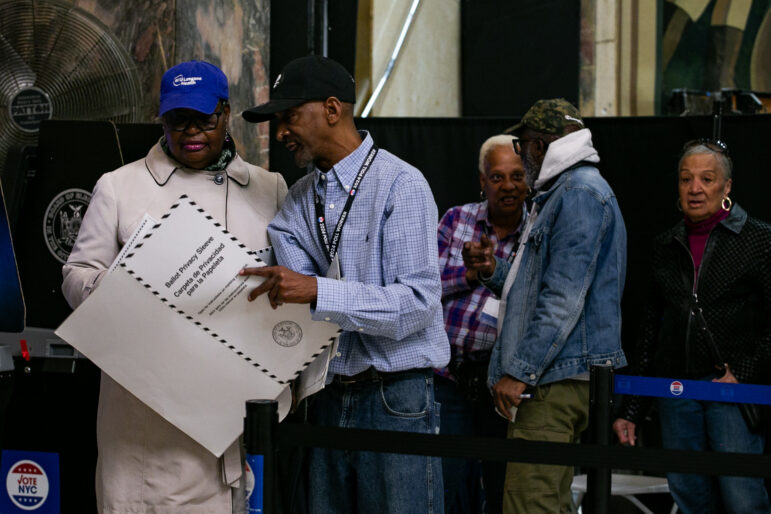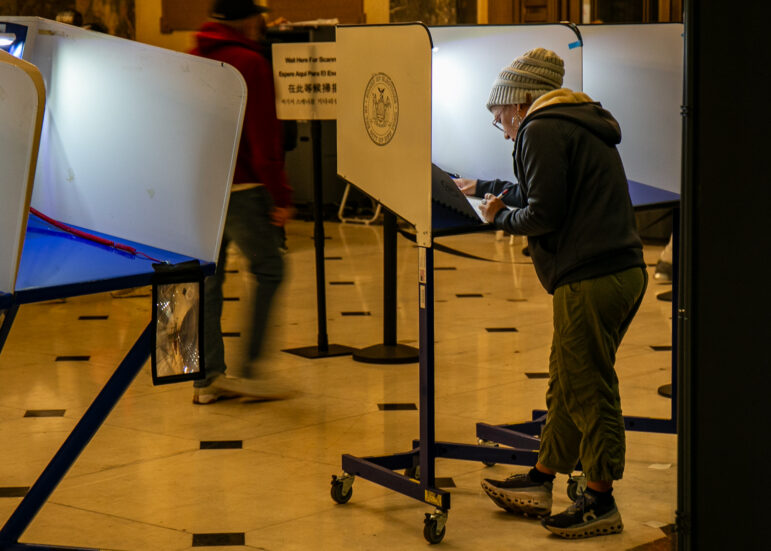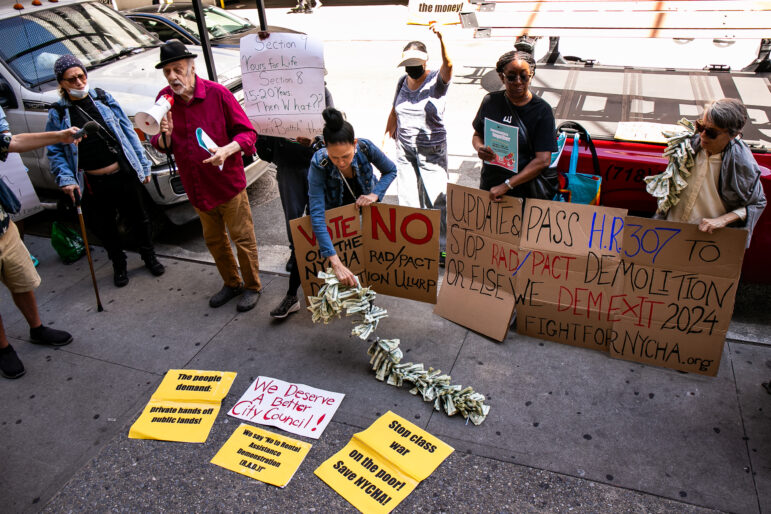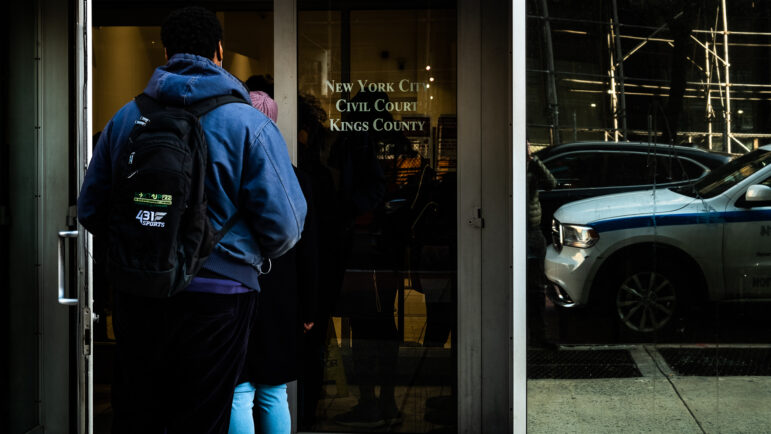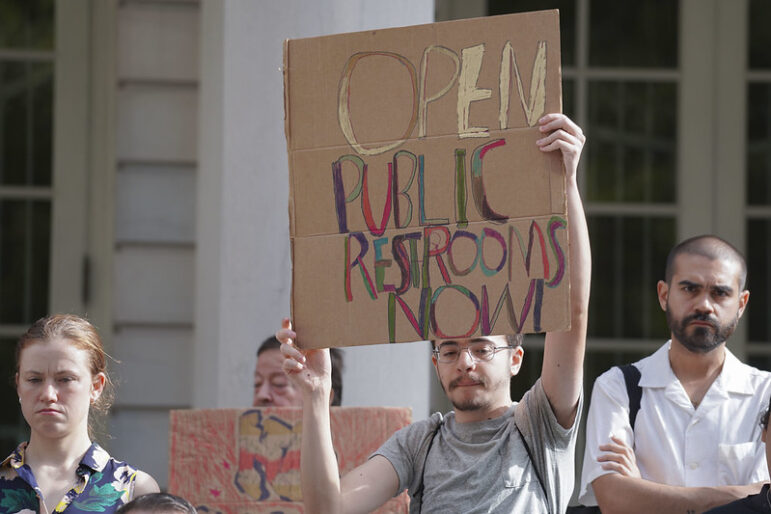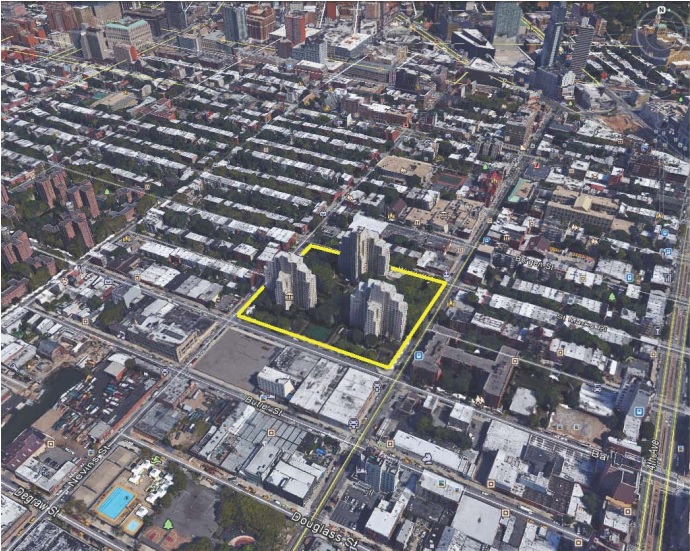
NYCHA
The Wyckoff Gardens development has a population of just under 1,200 people.
At Wyckoff Gardens, one of the first five NYCHA site targeted for new development, residents and housing advocates are protesting the authority’s recent announcement that it will release a Request for Proposal (RFP) for the development of Wyckoff’s land as early as April. Stakeholders say they’d been led to expect the RFP would not be released until late summer, a claim NYCHA denies, and contend that the early release deprives residents of the opportunity to meaningfully shape the parameters of the RFP.
“Last Tuesday’s announcement for an April release shows the blatant lack of trustworthiness,” says a letter (see below) to the authority signed by Michelle de la Uz of the Fifth Avenue Committee and Shatia Strother of Families United for Racial and Economic Equality, adding that they are “deeply concerned with the seemingly unaccountable changes and decisions being made without the buy-in and decision-making input of residents.”
NYCHA’s development program—which the authority calls “NextGen Neighborhoods” but some refer to as “the infill plan”—aims to generate revenue by taking purportedly underutilized public housing land and leasing it to developers to build new housing. The city hopes to target 50 to 60 developments over the next ten years, spurring the creation of 17,000 new units.
Though NYCHA has held dozens of engagement meetings with tenants at the first five proposed sites, tenants have repeatedly said their concerns have not been heard. When NYCHA announced the early release of the RFP at a meeting on March 15, Wyckoff tenant leaders say the authority confirmed their worst fears.
“It’s like they’ve just said: regardless of what you say or what you think, we’re going to do it anyway,” says tenant president Valerie Bell. “The residents don’t have a voice. [The authority] just wants them to feel like they’re being part of the decisions.”
In addition, many residents’ questions—from how revenue will be allocated, to a timeline for the repairs—remain unanswered, though at a recent hearing NYCHA justified this “vagueness” on the grounds that they were still collecting input from residents on the plan.
“If they move forward without addressing our issues, it just clearly shows that they have no care for the residents’ voice,” says former tenant president Charlene Nimmons.
NYCHA spokesperson Zodet Negron said in an e-mail to City Limits that the authority has always said the RFP would be released by the end of the first quarter of 2016. She added that NYCHA can’t determine a timeline for repairs or how revenue will be allocated until a developer is selected and the authority is able to quantify the “return to NYCHA” from the lease. (Separately, the Authority on Monday announced a change to the hours worked by operations staff to create a larger window for residents to get action and answers on repairs [see video here].)
But Strother said the authority told FUREE the RFP would be released in August, and FUREE planned to hold education workshops for residents on the ULURP process and RFP process throughout the spring, with the goal of crafting a platform of demands in May. Now, her organization is forced to impart resources to residents on a much shorter timeline, Strother said.
The letter also objects to the continued stalling of the formation of a community steering group to represent tenant interests. While NYCHA had previously agreed to the steering committee, on March 15 they said the committees would not be formed until after NYCHA had selected a developer.
While Mayor de Blasio’s infill program has met resistance from tenants, it differs significantly from the Bloomberg administration’s proposed version of the plan, which called for the construction of 80 percent market-rate and 20 percent affordable housing. De Blasio’s plan reverses those ratios, calling for the construction of 20 percent market-rate and 80 percent affordable housing for households making below $46,620 for a family of three. Under de Blasio’s plan, some NYCHA developments will get new housing that is 100 percent affordable while others, including Wyckoff, are slated to see new buildings that are split between affordable and market-rate.
NYCHA says it will assess developers’ applications in part based on the proposed mix of incomes for below-market units. Some public-housing residents worry that the income levels of the affordable units will not be affordable to NYCHA families, or that an infusion of wealthier residents will displace local affordable retail.
The authority kicked off the engagement process for Wyckoff Gardens and Holmes Towers in September, engaging residents with questions like “What building height would you prefer?” and “Which of these capital improvements should be addressed first?” On November 16, residents held a press conference, demanding better answers to their concerns and asking NYCHA to slow down the process, postponing the RFP release from January to the summer.
Nimmons says NYCHA has not met that challenge. At the Tuesday meeting she took a poll of the audience, asking residents how many opposed infill development. The majority of tenants raised their hands; only two indicated support, with none abstaining.
“This is being done under protest,” says Nimmons, who says Wyckoff residents are most concerned about congestion at the development and overcrowding in local schools.
If it must happen, tenants don’t want the new development to proceed without their input. At tenant association meetings, they’ve come up with some criteria for the new buildings: They should be no taller than the existing structures, there should be commercial space to incubate a resident business, and NYCHA should structure a financial deal with the developer that allows for continual generation of revenue. Furthermore, any revenue generated from the development should be first used for all repair needs at Wyckoff, with a percentage of the leftovers placed in a Wyckoff escrow account for the future.
At the March 15 meeting, NYCHA reported back on the results of listening sessions. The new buildings, the authority proposed, would include a total of 600 units—more than the 528 units currently on site—but would be spaced out in shorter buildings, with one on the corner of 3rd Avenue and Wyckoff and another on Nevins and Wyckoff. Potential ground-floor uses of the new buildings include a small business incubator, cooperatively-owned grocery store, cultural center or early education facility, among other ideas.
Residents’ concerns still abound. Some residents say the placement of the buildings will negatively impact lighting and window views, and others don’t like that the number of new units will exceed the number of current units. Residents also want a detailed list of needed repairs. Bell and Nimmons says there’s disagreement about what repairs NYCHA residents want and what NYCHA officials say needs to be done.
“We’re not in need of new roofing,” says Bell. “The stuff they see that we need, it was done.”
Some residents continue to question whether infill is necessary at all. The program is predicted to generate about $400 to $800 million over ten years, making only a small dent on NYCHA’s ten-year projected operating deficit of $2.5 billion and its $17 billion capital repair backlog. The day after the Wyckoff meeting, 500 public housing residents and advocates bused to Albany to ask the state to address NYCHA’s capital budget deficit in a different way: by giving NYCHA an additional $1 billion each year for the next 10 years.
But NYCHA says that though the authority will continue to request funding from the state and federal governments, the city must employ other strategies to address the dire needs of aging NYCHA buildings.
“We must operate realistically,” says NYCHA spokesperson Negron. “We cannot rest our hopes and our future on a bailout that may never come.”


